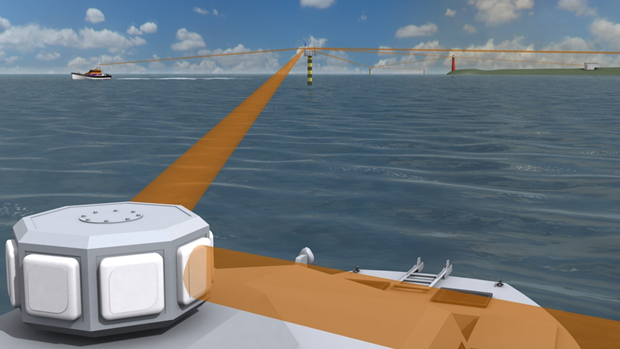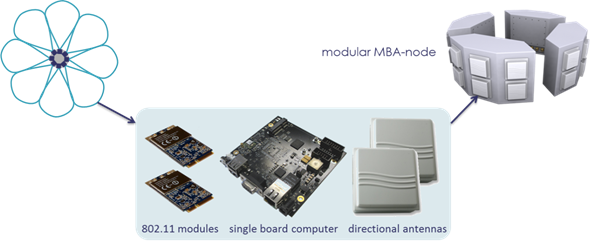Mobile Ad-hoc Routing in MaritimeManet

Mobile Ad-hoc Networking at Sea
Maritime organizations increasingly conduct operations at sea using multiple, possibly unmanned, platforms. An example for the Coast Guard is ‘distributed surveillance’ in which a large operational area is collectively inspected by unmanned surface vehicles (USV) and unmanned aerial vehicle (UAV), each carrying sensors with limited coverage. Video, image and data communication among those platforms is indispensable for such operations, while the distance between platforms at sea is generally relatively large. The maritime environment thus poses challenges for suitable communication within multi-platform systems.
MaritimeManet is an ad-hoc self-organizing wireless network that addresses these challenges. For radio communication, a MaritimeManet node uses a number of beams arranged in a sunflower pattern as shown left in Figure 1. The middle of the figure illustrates how each beam is created with state-of-the-art WiFi radio modules, a single board computer and a panel antenna to enable long distances transmission. The beams collectively cover all directions and thus enable communication in all directions. The resulting node, shown right in Figure 1, is called a Multi-Beam Antenna (MBA).
The fundamental principle in MaritimeManet is to automatically discover other nodes and to set up the strongest possible wireless connection between two nodes within radio reach by selecting the ‘best’ antenna at both nodes. To support connectivity while nodes move with respect to each other, MaritimeManet periodically selects the ‘best’ antenna at all nodes, which may result in handover of a connection to an adjacent antenna of a node. Movement of nodes may also lead to automatic removal of connections or to automatic creation of new connections.

Figure 1 – Composition of a single beam using commercial-off-the-shelf components.
Problem Statement:
In MaritimeManet, DND takes care of setting up the best possible topology among constituent MaritimeManet nodes at all times. A MaritimeManet network could be compared to a switched Ethernet where the cables are replaced with point-to-point wireless connections. Unlike switched Ethernet networks, the topology of MaritimeManet networks may change over time due to movement of the nodes. Each node in MaritimeManet must know to which next-hop node it must send data packets towards their final destination. This knowledge is provided by a routing algorithm. Though routing algorithms exist for decades and are a mature technology for fixed, wired topologies, there is still ongoing research on routing protocols for wireless networks with changing topology.
MaritimeManet is agnostic of the layer at which routing and data forwarding occurs. It can be at the datalink layer right above 802.x protocols, like the ‘Better Approach To Mobile Ad-hoc Networks’ (BATMAN), or it can be at IP layer where the ‘Open Link State Routing’ (OLSR) protocol is the most likely candidate. Since MaritimeManet is a wireless network, but has properties of wired networks in the sense that point-to-point wireless links created by directional antennas are only used, the applicability of both routing protocols mentioned above must be investigated. Especially the exclusive use of directional antenna’s in MaritimeManet may have consequences for correct operation of a routing protocol.
Tasks:
In MaritimeManet BATMAN will be used as the routing suite. BATMAN, like OLSR, has been invented with nodes using omni-directional antennas in mind. The presence of a single interface is therefore implicit in many aspects of the protocol. It is expected that optimizations can be found when applying BATMAN to nodes using directional antennas like MaritimeManet.
More specifically the student is expected:
- To study the Batman routing protocol and identify its strengths and weaknesses. See, e.g., [1]
- To analyze whether BATMAN is suitable for wireless networks using directional antennas
- To analyze if improvements in BATMAN are possible when used in conjunction with MaritimeManet
- To implement BATMAN in an existing MaritimeManet infrastructure
- To demonstrate the correct operation of BATMAN in a three-node network in which the nodes move w.r.t. each other and the topology dynamically changes
Work:
40% Theory, 40% Implementation and demonstration, 20% Writing
Contact:
Jan Laarhuis (j.h.laarhuis@utwente.nl)
Alessandro Chiumento (a.chiumento@utwente.nl)
References
[1] Batman wiki, Retrieved from: https://www.openmesh.org/projects/batman-adv/wiki
